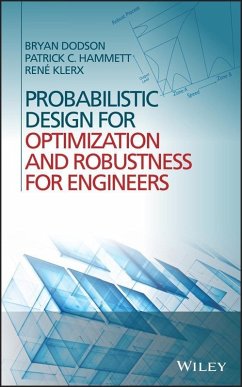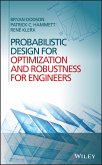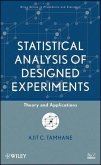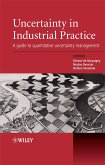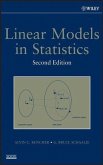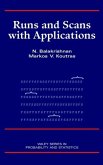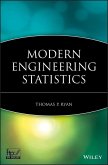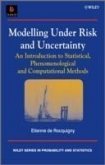Bryan Dodson, Patrick Hammett, Rene Klerx
Probabilistic Design for Optimization and Robustness for Engineers (eBook, PDF)
78,99 €
78,99 €
inkl. MwSt.
Sofort per Download lieferbar

0 °P sammeln
78,99 €
Als Download kaufen

78,99 €
inkl. MwSt.
Sofort per Download lieferbar

0 °P sammeln
Jetzt verschenken
Alle Infos zum eBook verschenken
78,99 €
inkl. MwSt.
Sofort per Download lieferbar
Alle Infos zum eBook verschenken

0 °P sammeln
Bryan Dodson, Patrick Hammett, Rene Klerx
Probabilistic Design for Optimization and Robustness for Engineers (eBook, PDF)
- Format: PDF
- Merkliste
- Auf die Merkliste
- Bewerten Bewerten
- Teilen
- Produkt teilen
- Produkterinnerung
- Produkterinnerung

Bitte loggen Sie sich zunächst in Ihr Kundenkonto ein oder registrieren Sie sich bei
bücher.de, um das eBook-Abo tolino select nutzen zu können.
Hier können Sie sich einloggen
Hier können Sie sich einloggen
Sie sind bereits eingeloggt. Klicken Sie auf 2. tolino select Abo, um fortzufahren.

Bitte loggen Sie sich zunächst in Ihr Kundenkonto ein oder registrieren Sie sich bei bücher.de, um das eBook-Abo tolino select nutzen zu können.
Probabilistic Design for Optimization and Robustness :
Presents the theory of modeling with variation using physical models and methods for practical applications on designs more insensitive to variation. | Provides a comprehensive guide to optimization and robustness for probabilistic design. | Features examples, case studies and exercises throughout.
The methods presented can be applied to a wide range of disciplines such as mechanics, electrics, chemistry, aerospace, industry and engineering. This text is supported by an accompanying website featuring videos, interactive animations to aid the readers understanding.…mehr
- Geräte: PC
- mit Kopierschutz
- eBook Hilfe
- Größe: 9.57MB
Andere Kunden interessierten sich auch für
![Probabilistic Design for Optimization and Robustness for Engineers (eBook, ePUB) Probabilistic Design for Optimization and Robustness for Engineers (eBook, ePUB)]() Bryan DodsonProbabilistic Design for Optimization and Robustness for Engineers (eBook, ePUB)78,99 €
Bryan DodsonProbabilistic Design for Optimization and Robustness for Engineers (eBook, ePUB)78,99 €![Statistical Analysis of Designed Experiments (eBook, PDF) Statistical Analysis of Designed Experiments (eBook, PDF)]() Ajit C. TamhaneStatistical Analysis of Designed Experiments (eBook, PDF)138,99 €
Ajit C. TamhaneStatistical Analysis of Designed Experiments (eBook, PDF)138,99 €![Uncertainty in Industrial Practice (eBook, PDF) Uncertainty in Industrial Practice (eBook, PDF)]() Uncertainty in Industrial Practice (eBook, PDF)99,99 €
Uncertainty in Industrial Practice (eBook, PDF)99,99 €![Linear Models in Statistics (eBook, PDF) Linear Models in Statistics (eBook, PDF)]() Alvin C. RencherLinear Models in Statistics (eBook, PDF)162,99 €
Alvin C. RencherLinear Models in Statistics (eBook, PDF)162,99 €![Runs and Scans with Applications (eBook, PDF) Runs and Scans with Applications (eBook, PDF)]() Narayanaswamy BalakrishnanRuns and Scans with Applications (eBook, PDF)169,99 €
Narayanaswamy BalakrishnanRuns and Scans with Applications (eBook, PDF)169,99 €![Modern Engineering Statistics (eBook, PDF) Modern Engineering Statistics (eBook, PDF)]() Thomas P. RyanModern Engineering Statistics (eBook, PDF)166,99 €
Thomas P. RyanModern Engineering Statistics (eBook, PDF)166,99 €![Modelling Under Risk and Uncertainty (eBook, PDF) Modelling Under Risk and Uncertainty (eBook, PDF)]() Etienne De RocquignyModelling Under Risk and Uncertainty (eBook, PDF)90,99 €
Etienne De RocquignyModelling Under Risk and Uncertainty (eBook, PDF)90,99 €-
-
-
Probabilistic Design for Optimization and Robustness:
The methods presented can be applied to a wide range of disciplines such as mechanics, electrics, chemistry, aerospace, industry and engineering. This text is supported by an accompanying website featuring videos, interactive animations to aid the readers understanding.
- Presents the theory of modeling with variation using physical models and methods for practical applications on designs more insensitive to variation.
- Provides a comprehensive guide to optimization and robustness for probabilistic design.
- Features examples, case studies and exercises throughout.
The methods presented can be applied to a wide range of disciplines such as mechanics, electrics, chemistry, aerospace, industry and engineering. This text is supported by an accompanying website featuring videos, interactive animations to aid the readers understanding.
Dieser Download kann aus rechtlichen Gründen nur mit Rechnungsadresse in D ausgeliefert werden.
Produktdetails
- Produktdetails
- Verlag: Wiley-IEEE Press
- Erscheinungstermin: 15. Juli 2014
- Englisch
- ISBN-13: 9781118796504
- Artikelnr.: 41209028
- Verlag: Wiley-IEEE Press
- Erscheinungstermin: 15. Juli 2014
- Englisch
- ISBN-13: 9781118796504
- Artikelnr.: 41209028
- Herstellerkennzeichnung Die Herstellerinformationen sind derzeit nicht verfügbar.
BRYAN DODSON, Executive Engineer, SKF, USA
PATRICK C. HAMMETT, Lead Faculty Six Sigma Program, Integrative Systems & Design, College of Engineering, University of Michigan, Ann Arbor, USA
RENÉ KLERX, Principal Statistician, SKF, The Netherlands
PATRICK C. HAMMETT, Lead Faculty Six Sigma Program, Integrative Systems & Design, College of Engineering, University of Michigan, Ann Arbor, USA
RENÉ KLERX, Principal Statistician, SKF, The Netherlands
Preface ix
Acknowledgments xi
1 New product development process 1
1.1 Introduction 1
1.2 Phases of new product development 2
1.2.1 Phase I-concept planning 3
1.2.2 Phase II-product planning 4
1.2.3 Phase III-product engineering design and verification 6
1.2.4 Phase IV-process engineering 9
1.2.5 Phase V-manufacturing validation and ramp-up 10
1.3 Patterns of new product development 11
1.4 New product development and Design for Six Sigma 13
1.4.1 DfSS core objectives 13
1.4.2 DfSS methodology 15
1.4.3 Embedded DfSS 16
1.5 Summary 17
Exercises 17
2 Statistical background for engineering design 19
2.1 Expectation 19
2.2 Statistical distributions 24
2.2.1 Normal distribution 24
2.2.2 Lognormal distribution 27
2.2.3 Weibull distribution 30
2.2.4 Exponential distribution 32
2.3 Probability plotting 34
2.3.1 Probability plotting-lognormal distribution 35
2.3.2 Probability plotting-normal distribution 36
2.3.3 Probability plotting-Weibull distribution 37
2.3.4 Probability plotting-exponential distribution 39
2.3.5 Probability plotting with confidence limits 40
2.4 Summary 43
Exercises 44
3 Introduction to variation in engineering design 46
3.1 Variation in engineering design 46
3.2 Propagation of error 47
3.3 Protecting designs against variation 48
3.4 Estimates of means and variances of functions of several variables 51
3.5 Statistical bias 59
3.6 Robustness 59
3.7 Summary 60
Exercises 61
4 Monte Carlo simulation 63
4.1 Determining variation of the inputs 63
4.2 Random number generators 64
4.3 Validation 66
4.4 Stratified sampling 70
4.5 Summary 74
Exercises 75
5 Modeling variation of complex systems 76
5.1 Approximating the mean, bias, and variance 77
5.2 Estimating the parameters of non-normal distributions 81
5.3 Limitations of first-order Taylor series approximation for variance 84
5.4 Effect of non-normal input distributions 91
5.5 Nonconstant input standard deviation 93
5.6 Summary 93
Exercises 95
6 Desirability 98
6.1 Introduction 98
6.2 Requirements and scorecards 99
6.2.1 Types of requirements 100
6.2.2 Design scorecard 101
6.3 Desirability-single requirement 103
6.3.1 Desirability-one-sided limit 104
6.3.2 Desirability-two-sided limit 106
6.3.3 Desirability-nonlinear function 107
6.4 Desirability-multiple requirements 109
6.4.1 Maxi-min total desirability index 114
6.5 Desirability-accounting for variation 115
6.5.1 Determining desirability-using expected yields 115
6.5.2 Determining desirability-using non-mean responses 116
6.6 Summary 118
Exercises 118
7 Optimization and sensitivity 123
7.1 Optimization procedure 123
7.2 Statistical outliers 128
7.3 Process capability 129
7.4 Sensitivity and cost reduction 133
7.4.1 Reservoir flow example 134
7.4.2 Reservoir flow initial solution 135
7.4.3 Reservoir flow initial solution verification 136
7.4.4 Reservoir flow optimized with normal horsepower distribution 138
7.4.5 Reservoir flow optimized with normal horsepower distribution
verification 140
7.4.6 Reservoir flow horsepower variation sensitivity 141
7.4.7 Reservoir flow horsepower lognormal probability plot 143
7.4.8 Reservoir flow horsepower Cpk optimization using a lognormal
distribution 144
7.5 Summary 149
Exercises 150
8 Modeling system cost and multiple outputs 153
8.1 Optimizing for total system cost 153
8.2 Multiple outputs 158
8.2.1 Optimization 159
8.2.2 Computing nonconformance 159
8.3 Large-scale systems 164
8.4 Summary 166
Exercises 167
9 Tolerance analysis 170
9.1 Introduction 170
9.2 Tolerance analysis methods 174
9.2.1 Historical tolerancing 174
9.2.2 Worst-case tolerancing 175
9.2.3 Statistical tolerancing 175
9.3 Tolerance allocation 178
9.4 Drift, shift, and sorting 179
9.5 Non-normal inputs 182
9.6 Summary 182
Exercises 182
10 Empirical model development 185
10.1 Screening 185
10.2 Response surface 193
10.2.1 Central composite designs 194
10.3 Taguchi 200
10.4 Summary 200
Exercises 201
11 Binary logistic regression 202
11.1 Introduction 202
11.2 Binary logistic regression 205
11.2.1 Types of logistic regression 205
11.2.2 Binary versus ordinary least squares regression 206
11.2.3 Binary logistic regression and the logit model 208
11.2.4 Binary logistic regression with multiple predictors 211
11.2.5 Binary logistic regression and sample size planning 211
11.2.6 Binary logistic regression fuel door example 212
11.2.7 Binary logistic regression-significant binary input 213
11.2.8 Binary logistic regression-nonsignificant binary input 214
11.2.9 Binary logistic regression-continuous input 214
11.2.10 Binary logistic regression-multiple inputs 215
11.3 Logistic regression and customer loss functions 217
11.4 Loss function with maximum (or minimum) response 220
11.5 Summary 223
Exercises 223
12 Verification and validation 225
12.1 Introduction 225
12.2 Engineering model V&V 228
12.3 Design verification methods and tools 230
12.3.1 Design verification reviews 230
12.3.2 Virtual prototypes and simulation 231
12.3.3 Physical prototypes and early production builds 232
12.3.4 Confirmation testing comparing alternatives 232
12.3.5 Confirmation tests comparing the design to acceptance criteria 233
12.4 Process validation procedure 233
12.5 Summary 238
References 239
Bibliography 242
Answers to selected exercises 246
Index 251
Acknowledgments xi
1 New product development process 1
1.1 Introduction 1
1.2 Phases of new product development 2
1.2.1 Phase I-concept planning 3
1.2.2 Phase II-product planning 4
1.2.3 Phase III-product engineering design and verification 6
1.2.4 Phase IV-process engineering 9
1.2.5 Phase V-manufacturing validation and ramp-up 10
1.3 Patterns of new product development 11
1.4 New product development and Design for Six Sigma 13
1.4.1 DfSS core objectives 13
1.4.2 DfSS methodology 15
1.4.3 Embedded DfSS 16
1.5 Summary 17
Exercises 17
2 Statistical background for engineering design 19
2.1 Expectation 19
2.2 Statistical distributions 24
2.2.1 Normal distribution 24
2.2.2 Lognormal distribution 27
2.2.3 Weibull distribution 30
2.2.4 Exponential distribution 32
2.3 Probability plotting 34
2.3.1 Probability plotting-lognormal distribution 35
2.3.2 Probability plotting-normal distribution 36
2.3.3 Probability plotting-Weibull distribution 37
2.3.4 Probability plotting-exponential distribution 39
2.3.5 Probability plotting with confidence limits 40
2.4 Summary 43
Exercises 44
3 Introduction to variation in engineering design 46
3.1 Variation in engineering design 46
3.2 Propagation of error 47
3.3 Protecting designs against variation 48
3.4 Estimates of means and variances of functions of several variables 51
3.5 Statistical bias 59
3.6 Robustness 59
3.7 Summary 60
Exercises 61
4 Monte Carlo simulation 63
4.1 Determining variation of the inputs 63
4.2 Random number generators 64
4.3 Validation 66
4.4 Stratified sampling 70
4.5 Summary 74
Exercises 75
5 Modeling variation of complex systems 76
5.1 Approximating the mean, bias, and variance 77
5.2 Estimating the parameters of non-normal distributions 81
5.3 Limitations of first-order Taylor series approximation for variance 84
5.4 Effect of non-normal input distributions 91
5.5 Nonconstant input standard deviation 93
5.6 Summary 93
Exercises 95
6 Desirability 98
6.1 Introduction 98
6.2 Requirements and scorecards 99
6.2.1 Types of requirements 100
6.2.2 Design scorecard 101
6.3 Desirability-single requirement 103
6.3.1 Desirability-one-sided limit 104
6.3.2 Desirability-two-sided limit 106
6.3.3 Desirability-nonlinear function 107
6.4 Desirability-multiple requirements 109
6.4.1 Maxi-min total desirability index 114
6.5 Desirability-accounting for variation 115
6.5.1 Determining desirability-using expected yields 115
6.5.2 Determining desirability-using non-mean responses 116
6.6 Summary 118
Exercises 118
7 Optimization and sensitivity 123
7.1 Optimization procedure 123
7.2 Statistical outliers 128
7.3 Process capability 129
7.4 Sensitivity and cost reduction 133
7.4.1 Reservoir flow example 134
7.4.2 Reservoir flow initial solution 135
7.4.3 Reservoir flow initial solution verification 136
7.4.4 Reservoir flow optimized with normal horsepower distribution 138
7.4.5 Reservoir flow optimized with normal horsepower distribution
verification 140
7.4.6 Reservoir flow horsepower variation sensitivity 141
7.4.7 Reservoir flow horsepower lognormal probability plot 143
7.4.8 Reservoir flow horsepower Cpk optimization using a lognormal
distribution 144
7.5 Summary 149
Exercises 150
8 Modeling system cost and multiple outputs 153
8.1 Optimizing for total system cost 153
8.2 Multiple outputs 158
8.2.1 Optimization 159
8.2.2 Computing nonconformance 159
8.3 Large-scale systems 164
8.4 Summary 166
Exercises 167
9 Tolerance analysis 170
9.1 Introduction 170
9.2 Tolerance analysis methods 174
9.2.1 Historical tolerancing 174
9.2.2 Worst-case tolerancing 175
9.2.3 Statistical tolerancing 175
9.3 Tolerance allocation 178
9.4 Drift, shift, and sorting 179
9.5 Non-normal inputs 182
9.6 Summary 182
Exercises 182
10 Empirical model development 185
10.1 Screening 185
10.2 Response surface 193
10.2.1 Central composite designs 194
10.3 Taguchi 200
10.4 Summary 200
Exercises 201
11 Binary logistic regression 202
11.1 Introduction 202
11.2 Binary logistic regression 205
11.2.1 Types of logistic regression 205
11.2.2 Binary versus ordinary least squares regression 206
11.2.3 Binary logistic regression and the logit model 208
11.2.4 Binary logistic regression with multiple predictors 211
11.2.5 Binary logistic regression and sample size planning 211
11.2.6 Binary logistic regression fuel door example 212
11.2.7 Binary logistic regression-significant binary input 213
11.2.8 Binary logistic regression-nonsignificant binary input 214
11.2.9 Binary logistic regression-continuous input 214
11.2.10 Binary logistic regression-multiple inputs 215
11.3 Logistic regression and customer loss functions 217
11.4 Loss function with maximum (or minimum) response 220
11.5 Summary 223
Exercises 223
12 Verification and validation 225
12.1 Introduction 225
12.2 Engineering model V&V 228
12.3 Design verification methods and tools 230
12.3.1 Design verification reviews 230
12.3.2 Virtual prototypes and simulation 231
12.3.3 Physical prototypes and early production builds 232
12.3.4 Confirmation testing comparing alternatives 232
12.3.5 Confirmation tests comparing the design to acceptance criteria 233
12.4 Process validation procedure 233
12.5 Summary 238
References 239
Bibliography 242
Answers to selected exercises 246
Index 251
Preface ix
Acknowledgments xi
1 New product development process 1
1.1 Introduction 1
1.2 Phases of new product development 2
1.2.1 Phase I-concept planning 3
1.2.2 Phase II-product planning 4
1.2.3 Phase III-product engineering design and verification 6
1.2.4 Phase IV-process engineering 9
1.2.5 Phase V-manufacturing validation and ramp-up 10
1.3 Patterns of new product development 11
1.4 New product development and Design for Six Sigma 13
1.4.1 DfSS core objectives 13
1.4.2 DfSS methodology 15
1.4.3 Embedded DfSS 16
1.5 Summary 17
Exercises 17
2 Statistical background for engineering design 19
2.1 Expectation 19
2.2 Statistical distributions 24
2.2.1 Normal distribution 24
2.2.2 Lognormal distribution 27
2.2.3 Weibull distribution 30
2.2.4 Exponential distribution 32
2.3 Probability plotting 34
2.3.1 Probability plotting-lognormal distribution 35
2.3.2 Probability plotting-normal distribution 36
2.3.3 Probability plotting-Weibull distribution 37
2.3.4 Probability plotting-exponential distribution 39
2.3.5 Probability plotting with confidence limits 40
2.4 Summary 43
Exercises 44
3 Introduction to variation in engineering design 46
3.1 Variation in engineering design 46
3.2 Propagation of error 47
3.3 Protecting designs against variation 48
3.4 Estimates of means and variances of functions of several variables 51
3.5 Statistical bias 59
3.6 Robustness 59
3.7 Summary 60
Exercises 61
4 Monte Carlo simulation 63
4.1 Determining variation of the inputs 63
4.2 Random number generators 64
4.3 Validation 66
4.4 Stratified sampling 70
4.5 Summary 74
Exercises 75
5 Modeling variation of complex systems 76
5.1 Approximating the mean, bias, and variance 77
5.2 Estimating the parameters of non-normal distributions 81
5.3 Limitations of first-order Taylor series approximation for variance 84
5.4 Effect of non-normal input distributions 91
5.5 Nonconstant input standard deviation 93
5.6 Summary 93
Exercises 95
6 Desirability 98
6.1 Introduction 98
6.2 Requirements and scorecards 99
6.2.1 Types of requirements 100
6.2.2 Design scorecard 101
6.3 Desirability-single requirement 103
6.3.1 Desirability-one-sided limit 104
6.3.2 Desirability-two-sided limit 106
6.3.3 Desirability-nonlinear function 107
6.4 Desirability-multiple requirements 109
6.4.1 Maxi-min total desirability index 114
6.5 Desirability-accounting for variation 115
6.5.1 Determining desirability-using expected yields 115
6.5.2 Determining desirability-using non-mean responses 116
6.6 Summary 118
Exercises 118
7 Optimization and sensitivity 123
7.1 Optimization procedure 123
7.2 Statistical outliers 128
7.3 Process capability 129
7.4 Sensitivity and cost reduction 133
7.4.1 Reservoir flow example 134
7.4.2 Reservoir flow initial solution 135
7.4.3 Reservoir flow initial solution verification 136
7.4.4 Reservoir flow optimized with normal horsepower distribution 138
7.4.5 Reservoir flow optimized with normal horsepower distribution
verification 140
7.4.6 Reservoir flow horsepower variation sensitivity 141
7.4.7 Reservoir flow horsepower lognormal probability plot 143
7.4.8 Reservoir flow horsepower Cpk optimization using a lognormal
distribution 144
7.5 Summary 149
Exercises 150
8 Modeling system cost and multiple outputs 153
8.1 Optimizing for total system cost 153
8.2 Multiple outputs 158
8.2.1 Optimization 159
8.2.2 Computing nonconformance 159
8.3 Large-scale systems 164
8.4 Summary 166
Exercises 167
9 Tolerance analysis 170
9.1 Introduction 170
9.2 Tolerance analysis methods 174
9.2.1 Historical tolerancing 174
9.2.2 Worst-case tolerancing 175
9.2.3 Statistical tolerancing 175
9.3 Tolerance allocation 178
9.4 Drift, shift, and sorting 179
9.5 Non-normal inputs 182
9.6 Summary 182
Exercises 182
10 Empirical model development 185
10.1 Screening 185
10.2 Response surface 193
10.2.1 Central composite designs 194
10.3 Taguchi 200
10.4 Summary 200
Exercises 201
11 Binary logistic regression 202
11.1 Introduction 202
11.2 Binary logistic regression 205
11.2.1 Types of logistic regression 205
11.2.2 Binary versus ordinary least squares regression 206
11.2.3 Binary logistic regression and the logit model 208
11.2.4 Binary logistic regression with multiple predictors 211
11.2.5 Binary logistic regression and sample size planning 211
11.2.6 Binary logistic regression fuel door example 212
11.2.7 Binary logistic regression-significant binary input 213
11.2.8 Binary logistic regression-nonsignificant binary input 214
11.2.9 Binary logistic regression-continuous input 214
11.2.10 Binary logistic regression-multiple inputs 215
11.3 Logistic regression and customer loss functions 217
11.4 Loss function with maximum (or minimum) response 220
11.5 Summary 223
Exercises 223
12 Verification and validation 225
12.1 Introduction 225
12.2 Engineering model V&V 228
12.3 Design verification methods and tools 230
12.3.1 Design verification reviews 230
12.3.2 Virtual prototypes and simulation 231
12.3.3 Physical prototypes and early production builds 232
12.3.4 Confirmation testing comparing alternatives 232
12.3.5 Confirmation tests comparing the design to acceptance criteria 233
12.4 Process validation procedure 233
12.5 Summary 238
References 239
Bibliography 242
Answers to selected exercises 246
Index 251
Acknowledgments xi
1 New product development process 1
1.1 Introduction 1
1.2 Phases of new product development 2
1.2.1 Phase I-concept planning 3
1.2.2 Phase II-product planning 4
1.2.3 Phase III-product engineering design and verification 6
1.2.4 Phase IV-process engineering 9
1.2.5 Phase V-manufacturing validation and ramp-up 10
1.3 Patterns of new product development 11
1.4 New product development and Design for Six Sigma 13
1.4.1 DfSS core objectives 13
1.4.2 DfSS methodology 15
1.4.3 Embedded DfSS 16
1.5 Summary 17
Exercises 17
2 Statistical background for engineering design 19
2.1 Expectation 19
2.2 Statistical distributions 24
2.2.1 Normal distribution 24
2.2.2 Lognormal distribution 27
2.2.3 Weibull distribution 30
2.2.4 Exponential distribution 32
2.3 Probability plotting 34
2.3.1 Probability plotting-lognormal distribution 35
2.3.2 Probability plotting-normal distribution 36
2.3.3 Probability plotting-Weibull distribution 37
2.3.4 Probability plotting-exponential distribution 39
2.3.5 Probability plotting with confidence limits 40
2.4 Summary 43
Exercises 44
3 Introduction to variation in engineering design 46
3.1 Variation in engineering design 46
3.2 Propagation of error 47
3.3 Protecting designs against variation 48
3.4 Estimates of means and variances of functions of several variables 51
3.5 Statistical bias 59
3.6 Robustness 59
3.7 Summary 60
Exercises 61
4 Monte Carlo simulation 63
4.1 Determining variation of the inputs 63
4.2 Random number generators 64
4.3 Validation 66
4.4 Stratified sampling 70
4.5 Summary 74
Exercises 75
5 Modeling variation of complex systems 76
5.1 Approximating the mean, bias, and variance 77
5.2 Estimating the parameters of non-normal distributions 81
5.3 Limitations of first-order Taylor series approximation for variance 84
5.4 Effect of non-normal input distributions 91
5.5 Nonconstant input standard deviation 93
5.6 Summary 93
Exercises 95
6 Desirability 98
6.1 Introduction 98
6.2 Requirements and scorecards 99
6.2.1 Types of requirements 100
6.2.2 Design scorecard 101
6.3 Desirability-single requirement 103
6.3.1 Desirability-one-sided limit 104
6.3.2 Desirability-two-sided limit 106
6.3.3 Desirability-nonlinear function 107
6.4 Desirability-multiple requirements 109
6.4.1 Maxi-min total desirability index 114
6.5 Desirability-accounting for variation 115
6.5.1 Determining desirability-using expected yields 115
6.5.2 Determining desirability-using non-mean responses 116
6.6 Summary 118
Exercises 118
7 Optimization and sensitivity 123
7.1 Optimization procedure 123
7.2 Statistical outliers 128
7.3 Process capability 129
7.4 Sensitivity and cost reduction 133
7.4.1 Reservoir flow example 134
7.4.2 Reservoir flow initial solution 135
7.4.3 Reservoir flow initial solution verification 136
7.4.4 Reservoir flow optimized with normal horsepower distribution 138
7.4.5 Reservoir flow optimized with normal horsepower distribution
verification 140
7.4.6 Reservoir flow horsepower variation sensitivity 141
7.4.7 Reservoir flow horsepower lognormal probability plot 143
7.4.8 Reservoir flow horsepower Cpk optimization using a lognormal
distribution 144
7.5 Summary 149
Exercises 150
8 Modeling system cost and multiple outputs 153
8.1 Optimizing for total system cost 153
8.2 Multiple outputs 158
8.2.1 Optimization 159
8.2.2 Computing nonconformance 159
8.3 Large-scale systems 164
8.4 Summary 166
Exercises 167
9 Tolerance analysis 170
9.1 Introduction 170
9.2 Tolerance analysis methods 174
9.2.1 Historical tolerancing 174
9.2.2 Worst-case tolerancing 175
9.2.3 Statistical tolerancing 175
9.3 Tolerance allocation 178
9.4 Drift, shift, and sorting 179
9.5 Non-normal inputs 182
9.6 Summary 182
Exercises 182
10 Empirical model development 185
10.1 Screening 185
10.2 Response surface 193
10.2.1 Central composite designs 194
10.3 Taguchi 200
10.4 Summary 200
Exercises 201
11 Binary logistic regression 202
11.1 Introduction 202
11.2 Binary logistic regression 205
11.2.1 Types of logistic regression 205
11.2.2 Binary versus ordinary least squares regression 206
11.2.3 Binary logistic regression and the logit model 208
11.2.4 Binary logistic regression with multiple predictors 211
11.2.5 Binary logistic regression and sample size planning 211
11.2.6 Binary logistic regression fuel door example 212
11.2.7 Binary logistic regression-significant binary input 213
11.2.8 Binary logistic regression-nonsignificant binary input 214
11.2.9 Binary logistic regression-continuous input 214
11.2.10 Binary logistic regression-multiple inputs 215
11.3 Logistic regression and customer loss functions 217
11.4 Loss function with maximum (or minimum) response 220
11.5 Summary 223
Exercises 223
12 Verification and validation 225
12.1 Introduction 225
12.2 Engineering model V&V 228
12.3 Design verification methods and tools 230
12.3.1 Design verification reviews 230
12.3.2 Virtual prototypes and simulation 231
12.3.3 Physical prototypes and early production builds 232
12.3.4 Confirmation testing comparing alternatives 232
12.3.5 Confirmation tests comparing the design to acceptance criteria 233
12.4 Process validation procedure 233
12.5 Summary 238
References 239
Bibliography 242
Answers to selected exercises 246
Index 251
